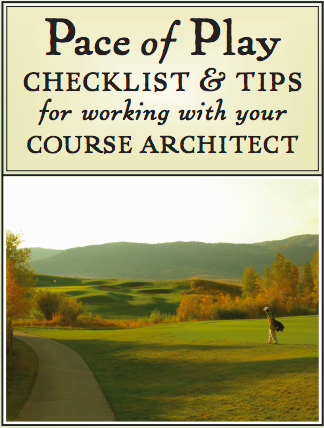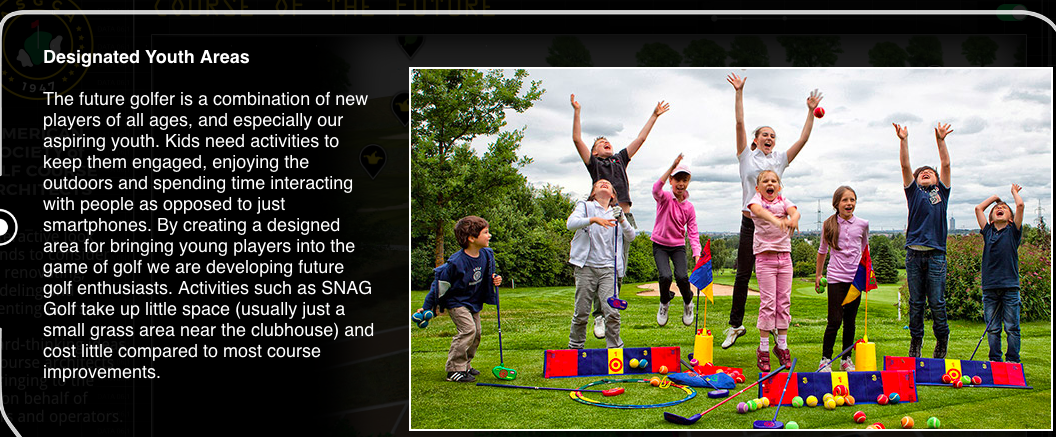Houston…Where Are We Going?

There’s a saying that the solution to a problem is often the simplest or most direct.
The American Society of Golf Course Architects, who recently held their annual convention in Houston, doesn’t seem familiar with this axiom.
In the last few weeks the organization has issued two “call to arms” promotions, one regarding pace of play and the other a schematic conception of what golf facilities of the future might be like. Both outlooks are labored, and worse, tone deaf to how they might enhance either the game or the business of architecture.
The society’s pace of play proposal isn’t necessarily egregious in intention. But the checklist it recommends clubs consider to help speed play (and presumably log more rounds) is overwrought, with seven different sections and 39 sub-items/tips that range from industry claptrap (“Have you implemented Play it Forward tools?”) to the ominously invasive (“How set-in-stone is your routing and footprint” and “Tee addition planning”).
Is all of this necessary to quicken rounds?
A further subtext is that, to amend pace of play problems, clubs may require help making subtle or not so subtle alterations to their golf course. In essence, architects could be hired to correct issues that were created…by other architects.
Faster rounds is a goal to which every course and player should aspire, but the ASGCA’s checklist badly misses the mark when it comes to the heart of the matter: the best way for a golf club to improve pace of play is to get players to play faster.

Regarding pace, the argument can be made that architects can only do so much, and at least they’re trying something.
More startling is the ASGCA’s vision for future courses, presented as “Forward-thinking ideas golf course architects are bringing to the table on behalf of owners and operators.” The interactive schematic envisions an outdoor (and indoor) panoply of various activities and potentialities at a model club, many that have nothing to do with golf itself.
Most instructive and worthwhile are the agronomic considerations, which propose potential water and turf reduction, a more organic bunker presentation and other innovations that are environmentally positive and can lower maintenance costs. Concepts like putting courses and shorter loops of holes also have value, even if they aren’t possible in most cases.
The rest is difficult to fathom. It’s extremely discouraging to see the ASGCA spending energy and resources promoting ideas like showing movies on driving ranges, incorporating exercise equipment next to golf holes or suggesting the marketing desirability of digital course fly-throughs.
Proposing two holes on each green, one easy and one more difficult for different skill sets, is an assault on the essence of the game. Other endorsements — installing high-tech golf simulators or sub-air systems beneath the greens — are simply impractical or dramatically misguided for the vast majority of golf courses.

If American architects believe the path to a better golf experience is radio-controlled boat ponds, outdoor mood lighting, footgolf and enhanced golf cart technology, they’ve officially lost their way.
If they believe these types of sideshows and otherwise costly ephemera will help attract new players and increase revenues, they’ve thrown in the towel.
We should expect better from the world’s leading professional association of golf course designers. I have high respect for these men and women individually and consider some of them my friends, but collective efforts such as this are a dispiriting breach of trust. I suspect many of them would agree with me.
We can only hope this model was a workshopped-to-death toss off, or perhaps home office’s excuse to utilize some computer software. But sadly missing in such ASGCA considerations of golf’s future is a fundamental impulse to peel away everything superfluous to the prominence of actually playing golf.
If the game and culture became imperiled in the 1990’s and early 2000’s, it was because American golf became increasingly business model-dependent and estranged from its roots as a vigorous walking sport. The recession and retraction that began in 2008 was a chance to reevaluate and re-set. Why does it feel like industry creep is setting back in?
As ASGCA member Tim Liddy said recently, “golf is aspirational.” It’s not for everybody, and it’s foolish to try to chase or appease every demographic. People will either fall in love with the game and find a way play it, or they won’t. And that’s okay, because the game of golf is okay. Promote that.
I would hope American golf course architects would realize that the course we need at this moment in time, not the future, is shorter, simpler, drier, walkable and perplexing. Efforts concentrated on maximizing these efficiencies create a paradigm in which people will fall in love with golf by playing it, not through tangental activities. Imagine.
Or think of it as another most simplest of rules: do nothing unless it benefits the game — not the business.
One Reply to “Houston…Where Are We Going?”
Thank you for protecting the game from the developer, marketer, promoter mania. Let those who love the game play and others make their own arrangements. Obsession with player numbers and growing the game through tinkering will kill it.